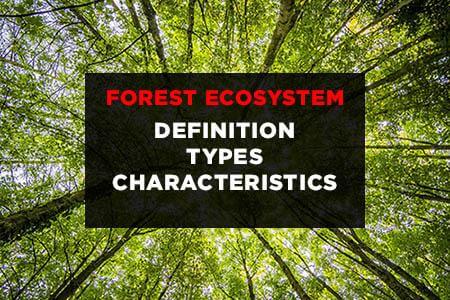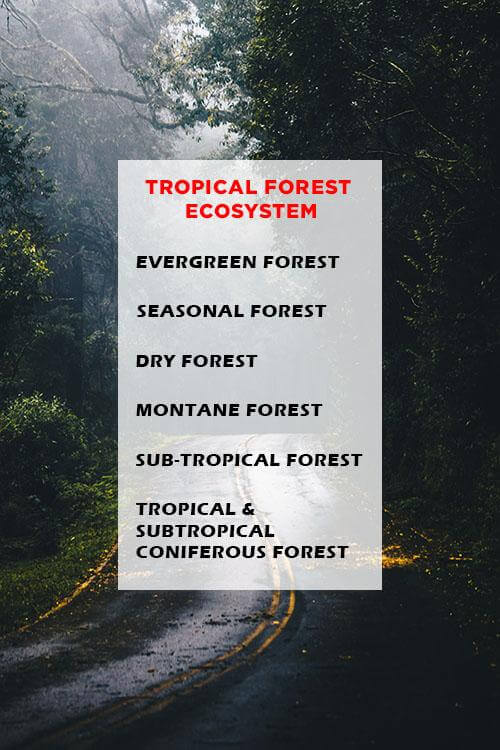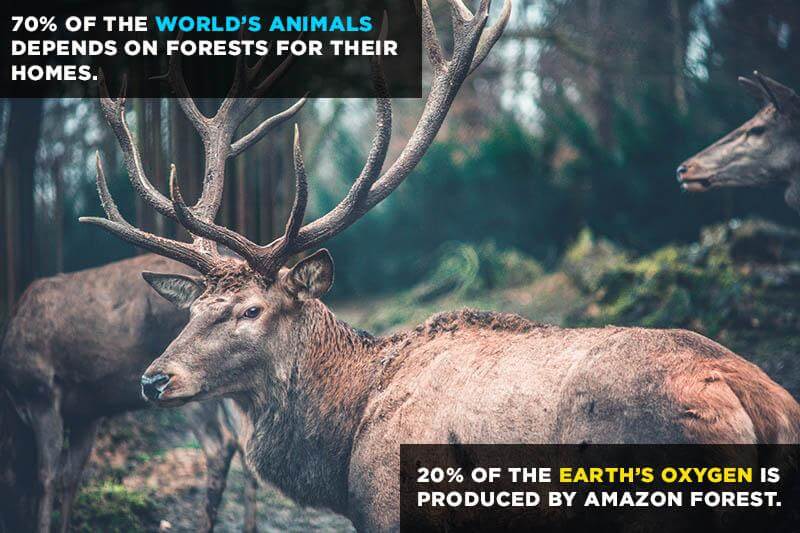Forest Ecosystem Definition – Types of Forest Ecosystem and Characteristics
Learn here definition as well as types of forest ecosystem along with their characteristics
Forest Ecosystem – An Overview
A forest ecosystem is a unique ecology, including a very nice community of flora and fauna. When we heard “forest,” the primary thing that comes to our mind is trees. An area covered with trees making various canopy layers is commonly known as a forest ecosystem.
Describing forest ecosystem – A forest ecosystem is a place that provides natural habitat to millions of plant and animal species. The forest ecosystems have been divided into different types based on the climatic conditions of that particular region – for example- tropical rainforest, temperate, etc.

You can go through this article to know more about such an incredible ecosystem i.e., about forest ecosystem, its climate, characteristics and types of forest ecosystem.
Table of Contents
Forest Ecosystem Definition
A natural woodland area making it a suitable place for the survival of biotic and abiotic components, is usually termed as a forest ecosystem. A forest ecosystem consists of various plants, animals, and other micro-organisms, making it a natural habitat for them.
The forest ecosystem plays an essential role in the environment. It helps to balance the climate of the planet. One of the major roles that forests play is that it provides us oxygen to breathe. Trees help to maintain the balance of carbon dioxide in the atmosphere. Besides this, forests also help to prevent soil erosion, rainfall, purifying the air, etc.
Types of Forest Ecosystem
Forest ecosystem has been classified into three major types – tropical forest ecosystem, temperate forest ecosystem and boreal ecosystem. We will also understand savanna ecosystem. The types of forest ecosystems have been divided based on latitude and different characteristics. The different types of forest ecosystems are as follows –
Tropical Forest Ecosystem
- Tropical forests, also known as tropical rainforest, receives almost 100 inches of rain every year. The tropical forest has a wide variety of species among all other types of forest ecosystems.
- Tropical forests are usually found in latitude between 23.5 degrees North and 23.5 degrees South. The temperature recorded in tropical forests is between 68 degrees and 77 degrees Fahrenheit.
- Heavy rainfall in the tropical forest leads to poor quality of soil due to a lack of nutrients. High-level rainfall throughout the year causes leaching of soil nutrients.
- The vegetation of the tropical rainforest mostly includes broad-leafed trees that are very tall about 82-115 feet height. Due to dense canopy, the sun finds it quite tough to reach the forest floor.
- The tropical forest is a home for millions of animals that includes a massive variety of birds, mammals, amphibians, reptiles, etc. Here you can find almost half the species of animals that lived on Earth.

The tropical forest ecosystem is again divided into different categories and types. These are –
Evergreen forest
The evergreen forest receives heavy year-round rainfall with no dry season.
Seasonal forest
Seasonal forest host evergreen flora with a short-time dry season.
Dry forest
As the name suggests, dry forests experience a long-period of the dry season.
Montane forest
Montane forests received most of the precipitation in the form of fog, hence also known as cloud forests.
Sub-tropical forest
The sub-tropical forest is found in North & South regions of tropical forests. The flora of this region is adapted to survive in the adverse conditions of summer drought.
Tropical & subtropical coniferous forest
This type of forest experiences dry & hot climatic conditions with conifers that are adapted to resist variable weather.
Temperate Forest Ecosystem
- Temperate forests are usually found in North America, Eurasia, Japan, etc. Temperate forest receives less rainfall as compared to tropical forests approximately 30-60 inches every year.
- Unlike tropical forests, temperate forests experience all the four seasons with variation in temperature. The winters in the temperate forest quite often experience temperature below freezing point, and in summers, the temperature becomes very high with a high level of humidity.
- The soil of temperate forest is rich in organic matter that allows a huge variety of vegetation to grow in the temperate forest.
- The temperate forest provides natural habitat to many animals such as squirrels, deer, black bears, raccoons, coyotes, various birds like warblers, owls, woodpeckers, hawks, etc.
The temperate forest ecosystem is further divided into two parts – Temperate Deciduous Forest and Temperate Coniferous Forest.
Temperate Deciduous Forest
- Temperate Deciduous forests experience four specific seasons. It receives annual rainfall between 30-60 inches. In winter, the temperate deciduous forest experience snowfall.
- The soil of this forest is quite fertile. As a result, you will find a wide variety of vegetation in the temperate deciduous forest, such as ferns, wildflowers, mosses, oak, birch, maple, etc.
- As far as the animal of temperate deciduous forests is concerned, you can find various animal species like the red fox, woodpecker, cardinals, hawks, etc.
Temperate Coniferous Forest
- The temperate coniferous forest ecosystem is usually found in coastal areas. Coniferous forests receive heavy rainfall throughout the year, approximately 50-200 inches.
- The floor of coniferous forests is mostly covered with a thick layer of decomposed matter. Temperate coniferous forest is covered with evergreen tall conifers.
- The most common plant species found in coniferous forests include cedar, Douglas fir, spruce, maple, cypress, pine, redwood, ferns, mosses, etc.
- The typical animal species found in this forest include deer, black bear, marbled murrelet, elk, marmot, spotted owl, etc.
Boreal Forest Ecosystem
The boreal forest is also known as Taiga forests are generally found in Siberia, Northern Asia, Canada, and Scandinavia. One of the main characteristics of the boreal forest is that it experiences short summers and very long winter seasons. Boreal forests receive approximately 15-40 inches precipitation every year (mostly receives in the form of snowfall).
The trees found in boreal forests are the evergreen type, such as pine, fir, spruce, etc. The boreal forest has a dense canopy that hardly allows the sun to reach the forest surface. This is why the vegetation is quite less in the forest floor.
The animals found in the boreal forest ecosystem are usually covered with thick fur to protect them from a long period of cold winters. Some examples of animals that lived in boreal forests are – elk, caribou, lynxes, wolverines, deer, snowshoe hare, moose, wolves, etc.
Savanna Forest Ecosystem
Savanna ecosystem is generally found in South America, Australia, and Africa. Savanna forests are quite vulnerable to forest fires; on the other hand, it has characterized by the ability to re-grow much faster.
The landscapes of the Savanna forest ecosystem are covered with large areas of green lands, bushes & clusters of feeble trees.
Characteristics of Forest Ecosystem
A forest ecosystem is quite diverse in characteristics. Some of these characteristics may sound very interesting to you. Here are some of the major characteristics of a forest ecosystem –

Seasonal variation
The forest ecosystem of a particular region depends on the seasonal variation of the country in which the forest falls. For example- tropical rainforests receive heavy rainfall every year, whereas temperate forests experience four seasonal variations.
Deciduous or evergreen in nature
A forest ecosystem may be deciduous or evergreen, or it may be a mix of both. The trees of a deciduous forest shed the leaves during the winter season, whereas evergreen trees always remain green.
Canopy layer structure
The canopy layer is one of the most distinguishing characteristics of a forest ecosystem. The dense canopy layers act as a barrier against wind, rain, snow, etc. to protect various species.
Some forest ecosystems, such as rainforests, are characterized by distinct layers of the canopy like treetops, upper canopy layer, lower canopy layer, and forest floor.
Attract bird species to take shelter
The forest ecosystem provides the most favorable conditions to various species of birds. As a result, these species get attracted by the forest ecosystem and take shelter on trees.
Attract insects & provide habitat
The forest ecosystem is home to a huge variety of insects. These insects found thousands of options as their shelter in the forest ecosystem. Hence, these insects get attracted to the natural habitats provided by the forest ecosystem.
Soil fertility
The soil of forest ecosystems varies in terms of fertility. For example- the soil of temperate and tropical deciduous forests is very fertile enriched with nutrients.
On the other hand, the soil of boreal forests is mostly acidic due to the falling of conifer needles on the forest floor. In the case of tropical rainforests, the soil is impoverished in terms of fertility due to continuous leaching on nutrients caused by heavy rainfall.
Forests are the natural treasure of mother Earth was given to us. Unfortunately, the forests around the world are getting destroyed mainly due to pollution & deforestation to fulfill our needs. It is high time to recall the importance of forest ecosystems towards the environment. Also remember, how you can help to protect the forest ecosystem to save millions of plant and animal species.